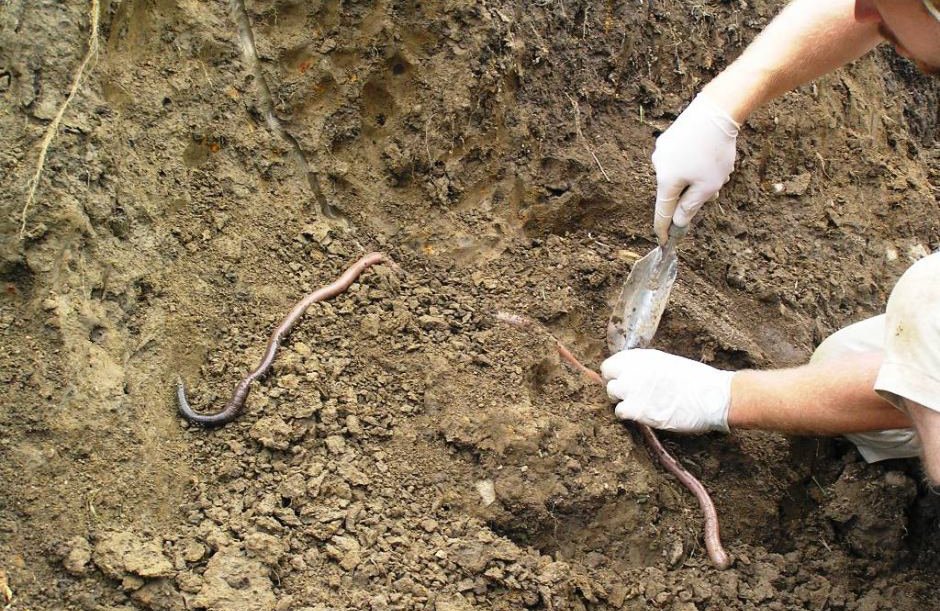The plight of the Giant Gippsland Earthworm

“I ACTUALLY started my research trajectory on mammals so I didn’t think I was going into the invertebrate world,” Dr Beverley Van Praagh, Australia’s leading expert on the giant Gippsland earthworm (Megascolides australis), tells Australian Geographic.
But after a joint project on the worm was announced between La Trobe University, where she was studying back in 1987, and the Worldwide Fund for Nature, Beverley made a big life decision. “I’ve just stuck with it,” she says. “I’ve done lots of other things along the way but my primary work has always been the giant Gippsland earthworm. They’re just fascinating.”
This earthworm species occurs only in a 40,000ha area in south and west Gippsland. Studying it hasn’t been easy. “People aren’t overly interested in working with invertebrates so funding hasn’t been easy to get and they are a protected species so they’re difficult to research,” Beverley explains.
We know very little about the worm’s physiology, other than it can grow up to three metres and has a high amount of haemoglobin in its blood to help it survive low-oxygen levels in underground environments.
But Australians are no less intrigued. “You know what Australians are like, they love big things,” says Beverley.
David Attenborough with the Giant Gippsland Earthworm.
The impact of farming
Land clearing across southern Gippsland began back in the late 1800s and by the 1930s there was nothing but roads, some creeks and pasture. According to Beverley, the first records of the earthworm come from the 1870s when farmers were surveying land across the Moe-to-Bunyip railway line along Brandy Creek in Warragal, Victoria.
“They actually thought it was a snake. That was the first time anyone had heard of giant earthworms. They sent them to the University of Melbourne where Professor Frederick McCoy then described it.
“When he had it laid out on the table —it would have been at least metre long or more — some assistants walked into the room and jumped in fright because they thought it was a snake.”
Despite its uniqueness and value to science, it would be a long time before much was understood about the worm’s habitat, particularly its complex, preferably soaking wet, burrowing systems.
One early account documented in The Land of the Lyre Bird: A Story of Early Settlement was particularly gruesome. “After the land was cleared, the farmers would plough the land,” Beverley says. “While they did this the fields would be red with blood from these worms. They would hang from the ploughs like spaghetti.”

(Image Credit: Bevereley Van Praagh)
Co-existence between farmers and worms
Beverley says that while land clearing and farming would have had a big impact on populations of the worm, it’s possible for farmers to co-exist with these creatures as long as the hydrology of an area isn’t altered.
“They’re okay under pasture if you’ve got nice blue-grey clay or red soils, underground springs or if you’ve got moisture coming in from a creek bank,” she says. “They need it to be relatively moist all year-round.” This is so the worm is able to move through its network of clay tunnels that can span several hundred metres.
Currently, Beverley is raising awareness about the damage that dense plantings can have on the earthworm’s habitat.
“It’s thought that earthworms occur in forested areas and some people want to plant their habitat back to how it was but we’ve found that the landscape has been altered and the earthworms are restricted to these pockets of earth that have remained suitably moist,” she says. “If you go and plant quite heavily on them that just takes all of the moisture out of the soil and makes it unsuitable for them.
“There’s been a real change in thinking when it comes to engaging people and the community, as well as landcare groups that it’s not a great idea to do such dense planting.”

(Image Credit: Beverley Van Praagh)
The elusive Giant Gippsland Earthworm
In the future Beverley says that she’d like to be able to monitor the species —specifically the impact of conservation efforts — using non-destructive techniques.
At the moment, she relies on the worm to squelch and squirm as loudly as possible to determine where exactly they are underground.
“You can hear them if you’re walking along, they’re really loud animals. Their burrows are soaking wet and they can move really quickly so when they move in response to vibration, you can hear this great big sucking or gurgling sound.”
Because there is very little interaction between different colonies of the worms, Beverley is also keen to begin genetic work to determine whether there are subspecies.
The government recently approved a new round of funding, which Beverley hopes not only goes to conservation efforts but will encourage young people to study the animal.
“Invertebrates tend to be at the bottom of the list when it comes to funding,” she says. “ You wouldn’t be able to do a project like the one I took on back in the 80s because it doesn’t have an economic outcome… The university’s funding system has changed.
“Sometimes for animals like these they’re a bit trickier.”
READ MORE:
- This deep sea ‘peanut worm’ is making everyone uncomfortable
- Lighting the night: glow worms around Australia
- The bright and colourful world of Christmas tree worms




